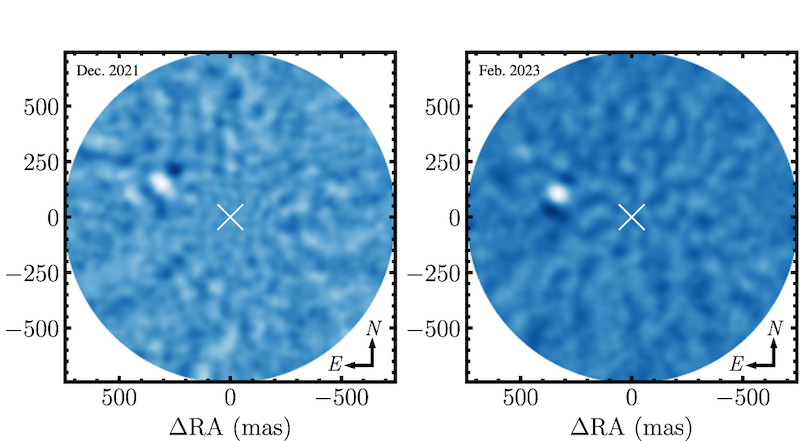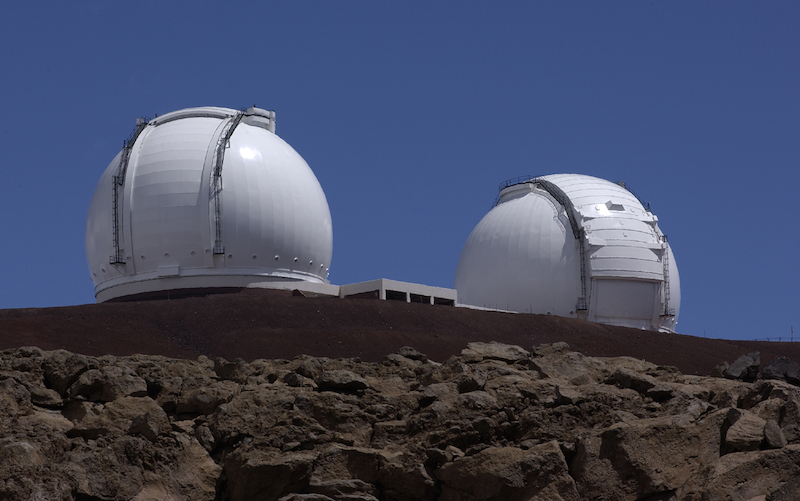
The number of directly imaged exoplanets may be relatively small compared to other detection methods, but that’s starting to change. Last week, astronomers using the Keck II telescope at the W. M. Keck Observatory in Hawaii released new images of one of the lowest-mass exoplanets yet to be seen this way. The planet, AF Lep b, orbits a young sun-like star 87.5 light-years away.
Kyle Franson at the University of Texas at Austin (UT Austin) led the new study. Franson and his colleagues published the peer-reviewed results in The Astrophysical Journal Letters on June 22, 2023.
Meet exoplanet AF Lep b
AF Lep b is a gas giant planet, about three times the mass of Jupiter. Its orbit around its star is also similar to those of the giant planets in our own solar system. It is, however, much younger. Its host star, AF Leporis, is only about 24 million years old. As the paper notes, it still resides within the circumstellar debris disk surrounding the young star.
Despite its size and mass, the planet is one of the lowest-mass exoplanets ever imaged directly.
The astronomers initially discovered AF Lep b using the astrometry method. With this technique, astronomers track the movement of a star over many years. The technique is very precise, detecting even tiny movements of the star. It is one of five techniques used to find exoplanets.
The researchers began taking astrometric images of the star back in 2021, continuing until this year. And, sure enough, they found a planet! Franson said:
When we processed the observations using the Keck II telescope in real time to carefully remove the glare of the star, the planet immediately popped out and became increasingly apparent the longer we observed.
In addition, two other research teams imaged the planet since 2021.
A new tool for exoplanet discovery
The discovery is the first time that astronomers have found a young planet like AF Lep b using astrometry. To date, this method has found far fewer planets than the other four methods. As co-author Brendan Bowler at UT Austin noted:
This is the first time this method has been used to find a giant planet orbiting a young analog of the sun. This opens the door to using this approach as a new tool for exoplanet discovery.
Astronomers had previously observed AF Leporis with the European Space Agency’s Hipparcos and Gaia satellites. Those observations, over 25 years, suggested that the host star might have a planet. Now, the new observations have confirmed it.
Astrometry measures a star’s position relative to other stars. The tiny changes in position – a “wobble” of the star – are caused by the gravitational pull of an orbiting planet. This technique shouldn’t be confused with the radial velocity method, however, which also measure’s a star’s wobble.

Direct images of AF Lep b
After the initial detection, the researchers used the Keck Observatory’s adaptive optics system to directly image the planet. Two technological advances made this possible. The optics correct for fluctuations caused by turbulence in Earth’s atmosphere. In addition, the Keck II Telescope’s Near-Infrared Camera 2 (NIRC2) Vector Vortex Coronagraph suppresses light from the host star. This allows the planet to be seen more clearly (even if still just a dot!). This was especially needed in the case of AF Lep b, since it is 10,000 times fainter than its star. It also orbits about eight times as far from its star as Earth does from the sun. Franson said:
Imaging planets is challenging. We only have about 15 examples, and we think this new ‘dynamically informed’ approach made possible by the Keck II telescope and NIRC2 adaptive optics imaging will be much more efficient compared to blind surveys that have been carried out for the past two decades.
AF Lep b is also an ideal target for NASA’s Webb Space Telescope and other telescopes. Bowler said:
This will be an excellent target to further characterize with the James Webb Space Telescope and the next generation of large ground-based telescopes like the Giant Magellan Telescope and the Thirty Meter Telescope. We’re already planning more sensitive follow-up efforts at longer wavelengths to study the physical properties and atmospheric chemistry of this planet.
Bottom line: Astronomers using the Keck II telescope in Hawaii have obtained new direct images of a young exoplanet three times the mass of Jupiter and 87.5 light-years away.











